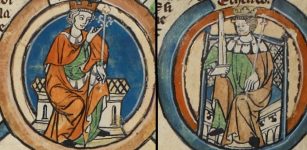Mysterious Ancient Grave With Unusual Artifacts That Belonged To A Völva – Norse Female Shamans Did Exist
Ellen Lloyd - AncientPages.com - A Völva in Norse mythology was someone everyone feared, even the gods. She was a powerful female shaman and seer, but was she only a mythological figure, or was there any proof of her existence?
Sometimes very unusual archaeological finds are made, giving us reason to ponder whether some of our ancestors’ stories are not based on actual events.
A very mysterious grave was discovered in Denmark. Several puzzling ancient artifacts were found in the tomb, indicating whoever was buried there was no ordinary person. What is especially interesting about this particular discovery is that it seems this was the resting place of a Völva.
While excavating near the Fyrkat Viking fortress, archaeologists found about 30 Viking Age graves, but one was more unusual.
A Viking-Age Woman Who Held High Status
Scientists found a woman dressed in fine blue and red clothes inside the tomb adorned with gold thread. Her clothes showed she was important and most likely held royal status. She had been given ordinary female gifts, like spindle whorls and scissors.
Reconstruction of Fyrkat Viking fortress. Image credit: Malene Thyssen - CC BY-SA 3.0
Being a rich woman, she was buried in the body of a horse-drawn carriage.
The grave contained exotic goods from foreign countries, something only rich people could afford at the time. Her toe rings were made of silver, which has not been found elsewhere in Scandinavia. Among her burial goods were two bronze bowls, which may have come from Central Asia.
Unusual Metal Wand And Poisonous Plants
It would be easy to say this was “only” a rich Viking woman, but some objects inside the grave suggest she was a Norse shaman.
The buried seeress from Fyrkat – reconstruction drawing by Thomas Hjejle Bredsdorff. Image credit: National Museum of Denmark
Scientists discovered an intriguing metal wand and seeds from the poisonous henbane plant inside her tomb.
These two particular accessories are associated with a Norse shaman because the name Völva (vǫlva) is Old Norse and means “wand carrier” or “carrier of a magic staff.” In Norse Sagas, a Völva is often described as an older woman who appears late at night. She is dressed in a dark foot-length cloak and holds a magical staff.
The metal wand in the grave had disintegrated after all those years, but experts could determine it was an iron stick with bronze fittings.
Left: A mysterious small cup, which the woman from Fyrkat also had with her in the grave. Its function is not known, but it may have been a small drinking cup. Right: Bronze cup, possibly originating from Central Asia. It had a grass cover and contained a fatty substance. Image credit: National Museum of Denmark
Inside a small purse, there were henbane seeds. During the Viking Age, such seeds were thrown by shamans into a fire because the plants were known to produce mildly hallucinogenic smoke and euphoric states.
Henbane was often used by the witches of later periods. It could be used as a “witch’s salve” to produce a psychedelic effect if the magic practitioners rubbed it into their skin.
Why was the woman buried with such plants unless she used them?
The Viking seeress’s cooking spit. The spit was already slightly bent when it was placed in the burial. Image credit: National Museum of Denmark
White lead was sometimes used as an ingredient in skin ointment in her belt buckle.
Scientists also discovered other mysterious artifacts that support the theory the woman inside the Fyrkat grave was a Völva.
At her feet was a box containing various items, such as owl pellets and small bird and mammal bones. Apart from these was a silver amulet shaped like a magic chair.
A so-called box brooch from Gotland was found in the grave. The völva re-used the hollow brooch as a container for “white lead.” White lead is a white dye that has been used in medicine for more than 2000 years - in skin ointments, for example. It is poisonous in its concentrated form. Image credit: National Museum of Denmark
We may never know the woman’s identity, but her burial goods show she was not a Viking warrior but a Völva. A Völva was a very respected woman, and warriors often visited her before going into battle. Her Poisonous plants could have been used before an important fight to give Viking warriors strength and courage.
It is, without a doubt, a fascinating archaeological discovery that gives a unique glimpse into our ancestor’s beliefs and shows some Norse myths were undoubtedly based on actual events and people.
Written by Ellen Lloyd – AncientPages.com
Updated on April 1, 2023
Copyright © AncientPages.com All rights reserved. This material may not be published, broadcast, rewritten or redistributed in whole or part without the express written permission of AncientPages.com
More From Ancient Pages
-
 Arborglyphs – Basque Immigrant Sheepherders Left Their Marks On Aspen Trees In The American West
Featured Stories | Jul 15, 2024
Arborglyphs – Basque Immigrant Sheepherders Left Their Marks On Aspen Trees In The American West
Featured Stories | Jul 15, 2024 -
 On This Day In History: Battle Of Marton, Part Of Viking Invasions Of England Took Place – On Mar 22, 871
News | Mar 22, 2017
On This Day In History: Battle Of Marton, Part Of Viking Invasions Of England Took Place – On Mar 22, 871
News | Mar 22, 2017 -
 Constructing Noah’s Ark – Re-Examination Of The Original Biblical Wording
Biblical Mysteries | Feb 1, 2018
Constructing Noah’s Ark – Re-Examination Of The Original Biblical Wording
Biblical Mysteries | Feb 1, 2018 -
 Naupa Huaca: The Enigmatic Stone Temple In A Cave In Peru
Featured Stories | Sep 10, 2020
Naupa Huaca: The Enigmatic Stone Temple In A Cave In Peru
Featured Stories | Sep 10, 2020 -
 Mysterious Ichthys – Ancient Secret Christian Symbol With A Deep Meaning
Ancient Symbols | Mar 6, 2018
Mysterious Ichthys – Ancient Secret Christian Symbol With A Deep Meaning
Ancient Symbols | Mar 6, 2018 -
 Spearhead Mound – Destroyed Burial Place Of Adena Giants?
Featured Stories | Jun 1, 2021
Spearhead Mound – Destroyed Burial Place Of Adena Giants?
Featured Stories | Jun 1, 2021 -
 Mystery Of The Chinchorro Civilization And The World’s Oldest Mummies
Civilizations | Dec 27, 2016
Mystery Of The Chinchorro Civilization And The World’s Oldest Mummies
Civilizations | Dec 27, 2016 -
 Cimmerians – Ancient People Searching For A Home
Civilizations | Feb 11, 2019
Cimmerians – Ancient People Searching For A Home
Civilizations | Feb 11, 2019 -
 Ancient European Buildings Form A Sacred Symbol When Viewed From The Air – Scientist Reveals
Ancient Symbols | Jun 15, 2018
Ancient European Buildings Form A Sacred Symbol When Viewed From The Air – Scientist Reveals
Ancient Symbols | Jun 15, 2018 -
 Princess Mkabayi KaJama: Condemned And Hated Zulu Kingmaker Who Died A Lonely Woman
Featured Stories | Mar 20, 2019
Princess Mkabayi KaJama: Condemned And Hated Zulu Kingmaker Who Died A Lonely Woman
Featured Stories | Mar 20, 2019 -
 Runic Inscription On The Forsa Ring Is Not What We First Thought – Scientists Say
Archaeology | Aug 15, 2024
Runic Inscription On The Forsa Ring Is Not What We First Thought – Scientists Say
Archaeology | Aug 15, 2024 -
 Utukku: Sumerian Spirit From The Underground That Obeyed The Will Of God Anu
Featured Stories | Jun 17, 2016
Utukku: Sumerian Spirit From The Underground That Obeyed The Will Of God Anu
Featured Stories | Jun 17, 2016 -
 Goddess Artemis – One Of The Most Respected Olympians
Featured Stories | Oct 1, 2016
Goddess Artemis – One Of The Most Respected Olympians
Featured Stories | Oct 1, 2016 -
 Mysterious Viking Code Jötunvillur Deciphered By Norwegian Researcher
News | Feb 24, 2014
Mysterious Viking Code Jötunvillur Deciphered By Norwegian Researcher
News | Feb 24, 2014 -
 Astonishing Pre-Inca Salt Ponds of Maras In Peru Were Created By The Chanapata Culture
Civilizations | Sep 14, 2016
Astonishing Pre-Inca Salt Ponds of Maras In Peru Were Created By The Chanapata Culture
Civilizations | Sep 14, 2016 -
 Why Are Christmas Ghost Stories So Fascinating?
Christmas Traditions | Dec 24, 2019
Why Are Christmas Ghost Stories So Fascinating?
Christmas Traditions | Dec 24, 2019 -
 Frey – Handsome Vanir God Of Fertility And Lord Of The Elves In Norse Beliefs
Featured Stories | Mar 3, 2018
Frey – Handsome Vanir God Of Fertility And Lord Of The Elves In Norse Beliefs
Featured Stories | Mar 3, 2018 -
 Dance Was A Gift Of The Gods To Ancient Greeks
Featured Stories | Oct 4, 2021
Dance Was A Gift Of The Gods To Ancient Greeks
Featured Stories | Oct 4, 2021 -
 Ancient Germanic Ghost Warriors – Romans’ Greatest Military Defeat And Nightmare
Featured Stories | Feb 18, 2019
Ancient Germanic Ghost Warriors – Romans’ Greatest Military Defeat And Nightmare
Featured Stories | Feb 18, 2019 -
 Abydos: One Of The Most Important Cities Of Ancient Egypt
Featured Stories | Jul 15, 2016
Abydos: One Of The Most Important Cities Of Ancient Egypt
Featured Stories | Jul 15, 2016






